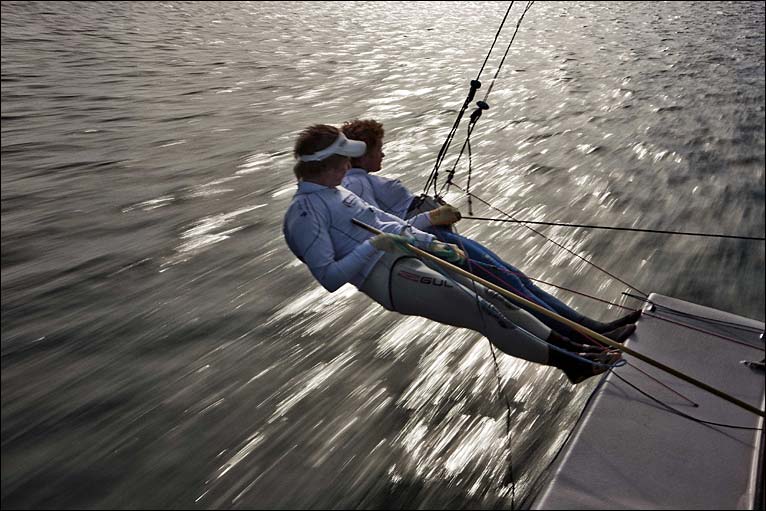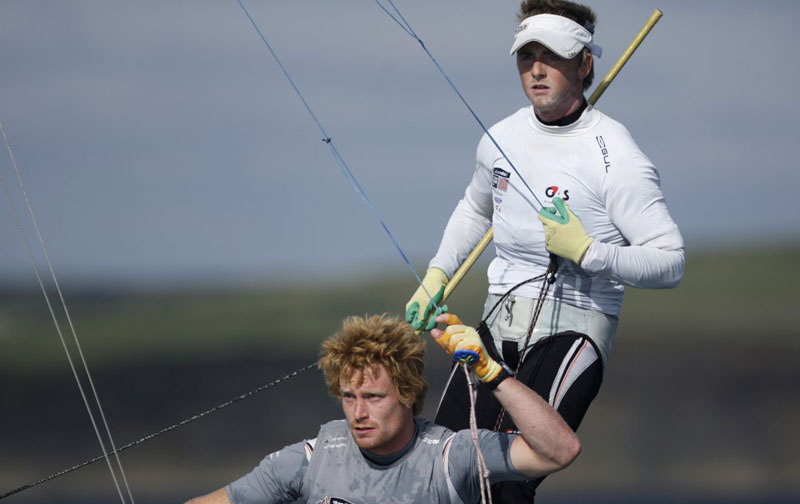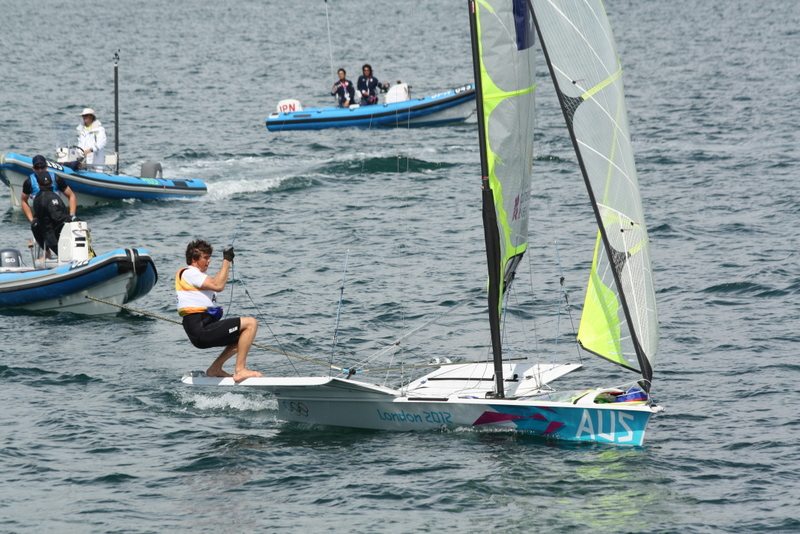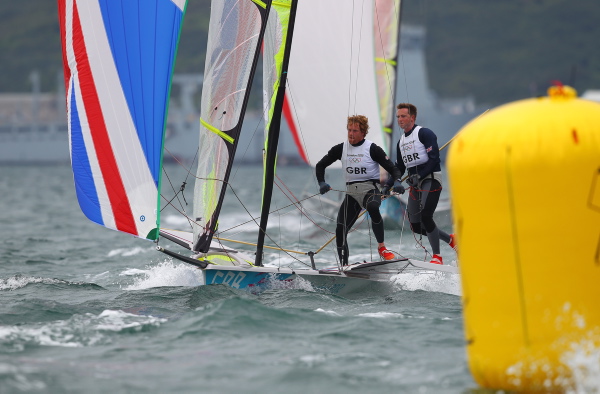GBR 49er Team - Stevie Morrison and Ben Rhodes
SailJuice: Stevie, you’ve qualified as part of Skandia Team GBR’s team to do the test regatta. There was one place available and there was – what – six British candidates that had a realistic chance of getting that slot.
Stevie: Definitely six really, really good British boats so it could have gone anywhere really.
SailJuice: Now, I hope you forgive me for saying, but it didn’t really look like it was going to go in your direction, in the direction of Stevie Morrison and Ben Rhodes until very recently, and then you’ve had a really good run in the last few weeks winning the Delta Lloyd regatta in Holland, beating the team that hardly anyone ever beats, the Aussie team of Nathan Outteridge and Iain Jensen, so a feather in your cap there. And then getting the bronze in Weymouth recently was enough to secure your spot for the test event. But why has life been so tough for you compared with your real purple patch back in the old rig days of 2007/2008?
Stevie: I think there’s a lot of things, obviously you touched on the rig, the boat’s very different, obviously it still looks like a 49er and still called a 49er but it’s pretty different. The rig’s a lot better, bit more modern. That’s taken obviously a bit of getting to grips with and I think we’ve probably taken a few wrong paths with that.
SailJuice: How do you take a wrong path with the one design, what sort of things are you talking about?
Stevie: Well it’s one design but you know as well as I that one designs are a loose term. I was speaking to Paul Goodison about the boat that many people regard as the ultimate one design isn’t perhaps all identical – at the end of the day they’re made by humans and there’s an element of human error, and I think, not the way you sail the boats like robots or were that great, but you do notice even the smallest of differences in just, you know, the masts and the sails and another sleeve. As anyone will know how well the mast and sail fits together then that has a huge effect on your speed, and I think we’ve kind of played around with different sections of masts that we know are different in how they bend and we’ve looked at different sails that look different so therefore they must be different. And what we thought we were looking for or trying to achieve we didn’t do a great job, and obviously it’s a complicated sport, sailing.
SailJuice: You’re not a very complicated guy, are you Stevie?
Stevie: Not overly complicated, no. Pretty much bangers and mash, me. But we’ve taken some wrong choices I suppose and I thing that’s not helped us a lot and you can over think things – you might be surprised at that of me – but you can over think things and we’ve struggled a little bit to get things going as we’d like and it’s hard if you’re not quick it’s blooming’ hard to do well. So we struggled a little bit with that but we’ve been working hard and you try and keep as positive as possible. A big part of it was the fact that the Olympics – we obviously didn’t have a great regatta in Beijing – long time ago now – but that sort of knocks your confidence and I suppose during that purple patch everything was easy, we were going quick, we probably didn’t necessarily realise how quick or fully understand why we were as quick as we were, but we were quick and Ben and I, I like to think, are pretty good sailors. If you put us in a fast boat we can do a pretty good job with that and we did back then. You don’t become a bad sailor overnight but if you can’t quite find that little notch of speed then you can struggle. Guys like Russell Coutts and people like that, they were so good in their Americas Cup for so many years in those old boats they had, but they seemed to just be able to get the boat to go a fraction traction quicker and suddenly it becomes very hard for them to be beaten, and I think that’s the case that we found in the 49er.
SailJuice: You’ve come back into this good patch winning Delta Lloyd. I think one of you said in an interview straight after winning that, that was the first one that you’d won in 3 years. I was amazed when I heard that, it didn’t seem like it had been that long ago but something is going right now. What’s going right for you now? Is it a boat speed change or an attitude change or what?

Morrison and Rhodes 49er Campaign
Stevie: Well the boat’s now a bit easier to sail so for us to go kind of at race pace is easier, so you’ve got more time to concentrate on the racing. Perhaps you go away and do a lot of tuning, a lot of training and all the rest of it and we could be pretty much going a similar speed to the other British guys and hanging in there, but as soon as you let them get into a race situation where you can’t really afford to concentrate on the boat going fast quite as much, then we struggled. That was I suppose our problem, you can hide the fact that you’re not that quick by really concentrating on the tuning runs and really concentrating in the little training exercises, but when you actually get into a race and there’s 25 others, there’s no point in kidding yourself, they’re all blooming’ good and any one from 1 to 25 are fantastically good sailors. And so if you’re struggling a little bit to go the same speed as them, as soon as you then look out the boat to try and look at the wind shifts or where the fleet is or even find where the mark is, your speed suffers and now the boat’s a little bit easier to sail and go at the speed we’d like it to go at. So suddenly a whole world of opportunities open up to you.
SailJuice: Is that one of the things that – the boat, for all the fact that it’s got a bigger rig now, but it’s also got a lighter rig, is it actually easier to sail to a reasonable level through the water and therefore it’s harder to excel?
Stevie: Possibly. I think there’s almost more fine adjustments you could make. Before the rigs used to kind of collapse if you like, so if you’re on the wrong setting you would really suffer, so everyone was a bit less subtle with the tuning of it, it had a rough place you needed to put it and if it was good kit it would go all right, whereas with these masts, they’re quite a lot better and I think you can make more fine adjustments. So there’s definitely still the little gains to be had there. You look at Nathan and Gooby and they’ve definitely still got a slight edge, they sail very, very well, don’t get me wrong. They’re tactically very smart and all the basics are in place but definitely they get the boat to slip through the water pretty quick all the time.
So I think there’s scope to find the little edges, but there’s maybe an element of the boat being a touch easier to sail in terms of the handling and stuff like that. Although it’s a bigger sail, the rig’s an awful lot lighter and so, but handling and things like that are kind of not quite such an issue, and also everyone’s been doing it four years longer, and the 49er as you know when you used to sail it, Ricey, back in the day, it was more of a battle of attrition and kind of getting round and even in Cascais and places like that it was a windy event, there were still people perhaps who weren’t able to concentrate on the racing quite as much because boat handling was an issue and Ben and I, it’s always been a strong point for Ben and I, seafaring skills, and we’ve always got the boat –
SailJuice: You’re from Smugglers’ Country, aren’t you?
Stevie: Yeah, well we’ve got a lot of evenin’ s in pub with fishermen, you know, that can give you some tips on getting in on the scariest of days. Definitely that is an area where the whole fleet people have caught up and everyone can sail a boat a lot better and the standard of racing because of that is on its way up.
SailJuice: Talking of precious metals and things like that, I read recently that you say you got bored of bronze. Too much bronze, not enough golds. What are you going to do to smuggle your way to gold, get past those Aussies, for example?
Listen to the interview in the audio player below...







Ben Rhodes overcame numerous injury setbacks to qualify for his second Olympics in the 49er event with Stevie Morrison, where they finished fifth. The pair are back on the campaign trail for Rio 2016

Stevie Morrison competed at his second Olympics in 2012, sailing with Ben Rhodes in the 49er event where they finished fifth after a tough battle against injury and selection. The pair are campaigning again in the 49er for Rio

 With gold and silver already wrapped up by Australia and NZ (training partners, by the way), all the excitement in the 49er finale focused on which of five teams would take bronze....
With gold and silver already wrapped up by Australia and NZ (training partners, by the way), all the excitement in the 49er finale focused on which of five teams would take bronze....
 Stevie Morrison and Ben Rhodes showed extreme composure to score fourth and second places today. With the 49ers having completed six races all boats are able to discount their biggest score of the series, an event that catapulted the Brits up the leaderboard from 12th to fifth place overall, just three points off the medal spots.
Stevie Morrison and Ben Rhodes showed extreme composure to score fourth and second places today. With the 49ers having completed six races all boats are able to discount their biggest score of the series, an event that catapulted the Brits up the leaderboard from 12th to fifth place overall, just three points off the medal spots.